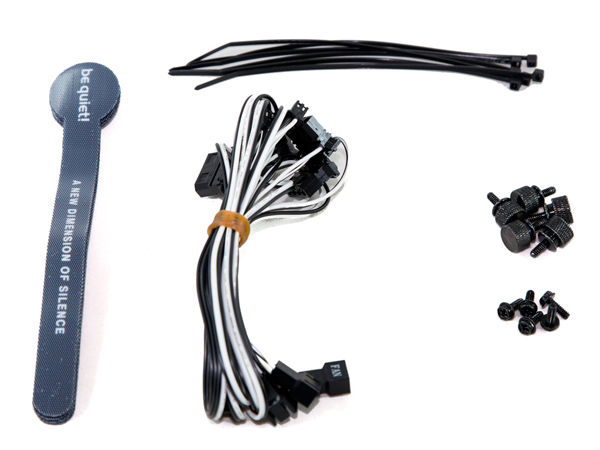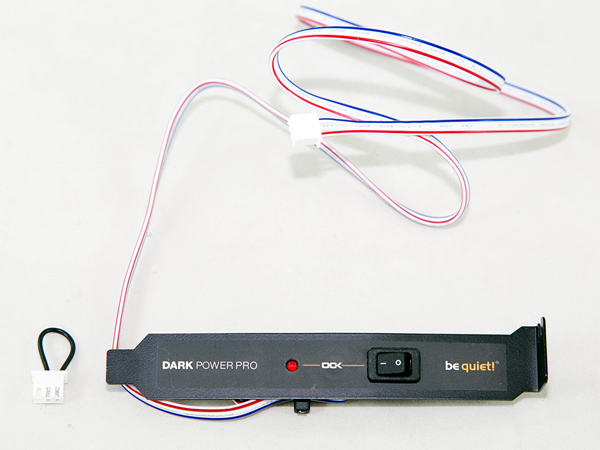be quiet! Dark Power Pro 11 850W Power Supply Review
Why you can trust Tom's Hardware
Packaging, Contents, Exterior And Cabling
Packaging






The Pro 11 package is similar to what we saw from the Dark Power Pro 10. On the front is a photo of the PSU with the 80 PLUS Platinum badge in the top-left corner, along with two icons indicating the use of the SilentWings fan and a modular cabling design. You'll find a multilingual feature description on the sides, and on the back is a scheme with the available connectors, complete with cable lengths, the power specifications table, and the PSU's dimensions.
Contents









The PSU is totally covered by packing foam for adequate protection. The bundle is rich and consists of Velcro straps and zip ties, two set of screws, all needed cables and an informative manual.
Included with the PSU is a bracket that houses the overclock switch. If you don’t want to use this bracket and just want to set the unit to single-rail mode, you can use the provided jumper wire.
Exterior













The look is great, and so is the finish. But it’s also a fingerprint magnet, so we had to treat the Dark Power Pro 11 with special care during our photo shoot. The labels on the sides depicting the unit’s model number are high-quality, and the power specifications label is installed at the bottom. The only thing that looks out of place is the typical honeycomb-style mesh on the front, which doesn’t match the unique top fan grille.
The unit is large, which can be a problem in smaller cases. However, if you need an 850W PSU, you'll probably have a chassis capable of housing it. The rear modular panel includes many sockets; the single white one destined for the overclocking key. Although the single native cable is required by every system because it hosts the 24-pin ATX connector, we would have preferred that this to be modular as well. We are well aware that be quiet! insists on having this specific cable fixed. Many users want all PSU wires to be modular, though.
To further restrict noise output, be quiet! equips this PSU with rubber edges to absorb vibrations. Previous Dark Power Pro supplies had this feature as well.
Cabling









We were surprised to find non-stealth cables on a high-end PSU. Personally, we don’t mind them, but some enthusiasts will. We also prefer flat, ribboned cables to the classic ones.
Get Tom's Hardware's best news and in-depth reviews, straight to your inbox.
Current page: Packaging, Contents, Exterior And Cabling
Prev Page Introduction Next Page A Look Inside And Component Analysis
Aris Mpitziopoulos is a contributing editor at Tom's Hardware, covering PSUs.
-
Xivilain For lower wattage units, I'd be interested in seeing fanless designs. But it doesn't seem like BeQuiet! is targeting that market, which is sad, because there are lots of HTPC builders out there demanding silence in their living rooms. Anyawy, great review!Reply -
Aris_Mp fanless designs target a very specific market segment mostly because of their increased cost. From the moment you can have inaudible operation at light-mid loads with a proper designed, normal PSU I would highly prefer it especially since it can deliver more power when needed (but with the fan spinning at high enough speeds), than a passive one which will be restricted at 550 - 600 W tops.Reply -
Shankovich ReplyFor lower wattage units, I'd be interested in seeing fanless designs. But it doesn't seem like BeQuiet! is targeting that market, which is sad, because there are lots of HTPC builders out there demanding silence in their living rooms. Anyawy, great review!
I don't see why you cannot have a lower powered unit at 80PG and have the fan run at a low speed. I got a HX750i because I need to give a FirePro W9100 very stable power, but the principle is the same: fan turns on at some higher wattage usage (for me it's 300, but for 80PG I'd say 200 is safer). Even when the fan turns on, can't hear it at all (it has a test button).
If someone makes a 600W PSU that has this kind of fan profile, that would be a score. It won't technically be fanless quite, but the fans won't even get past 15dB for average user power usage, and around 20dB at max settings. Why all this? Will lower the price since a lower efficiency can be used. -
Giannis Karagiannis Since you can have the fan spinning at very low rpm or not at all during light and normal use I can't see a point in having a fanless PSU. During heavy loads, when you need more than 300 watts of power, I believe the noise from the PSU fan would the last thing that would be annoying you.The heat produced be the rest of the system components would be so much that you would need active cooling anywayReply
Another very comprehensive review. Keep up the good work! I would also like to see more reviews for power supplies in the sub-100$ price range. -
dudmont "The prices of the 850, 1000 and 1200W units in the U.S. are $200, $240 and $280, respectively." Yikes!Reply
I'm not convinced that a quieter PSU is where it's at. It's cooling fans that create the big noise, not the PSU and it's fan.
-
Aris_Mp be quiet! informed me that this design/platform was actually designed by one of their engineers and not by FSP, which only helped them build it through their production facilities (since be quiet! doesn't have a PSU manufacturing line).Reply
So in other words be quiet! didn't just bought this platform from FSP but they designed it on their own and FSP just produced it for them.
Until now I wasn't aware of it but now that I am, I wanted to make things right and provide the proper credit to be quiet's engineer that designed this platform (whose name is unknown to me).